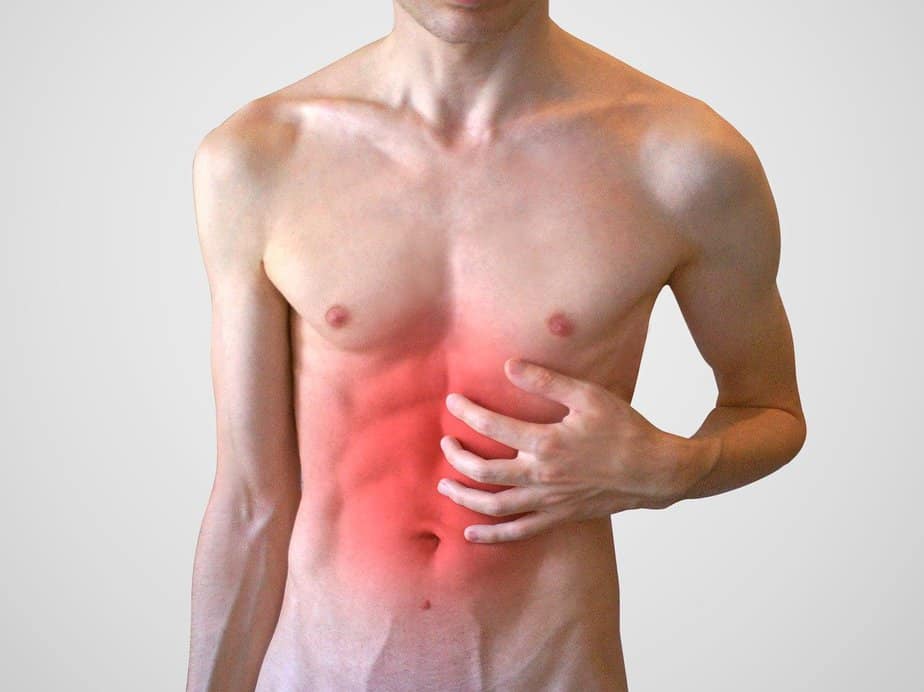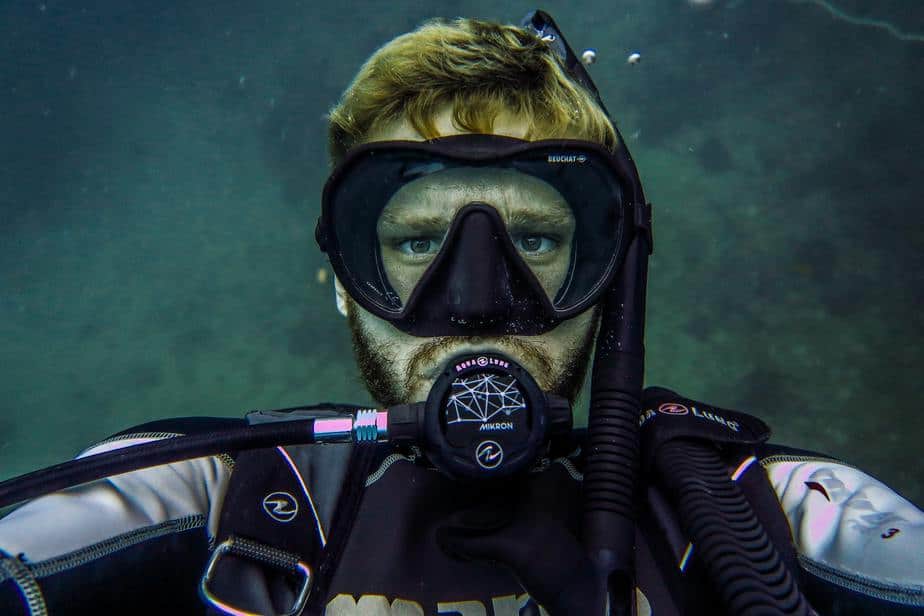Vomiting while scuba diving is perhaps one of the most uncomfortable experiences that a diver can experience. Not only is it uncomfortable, it’s also legitimately dangerous because divers have lost their lives doing this.
What are some factors that can result in vomiting while scuba diving, how can one prevent it from happening, and how should one handle vomiting underwater? One may vomit from the nausea caused by seasickness, vertigo, or a negative reaction from something they ate earlier. If you feel ill before or during a dive, consider canceling or ending the dive immediately to not have to deal with vomiting underwater. If you cannot hold back the vomit and you’re underwater already, then you should keep the regulator in your mouth and vomit into it. If your primary regulator gets clogged because of the vomit, then switch to your octopus and immediately end your dive.
The real danger to vomiting while scuba diving is the urge to breathe immediately afterwards. If one removes the regulator to vomit but then involuntarily takes a breath afterwards, they will get a mouthful of water and possibly panic, which is why leaving the regulator in the mouth is so important. We’ll discuss other ways you can handle or prevent vomiting while scuba diving so that you can get through this potential situation smoothly.
Vomiting underwater is not often talked about
In the same way that people don’t like to openly discuss peeing in their wetsuit because it’s kind of a disgusting topic and embarrassing to admit, vomiting during a dive is another one of those topics that people don’t like to bring up.
Unfortunately, this leads to situations where, should a new diver feel the urge to vomit while underwater, they have no idea what to do and panic. It’s not the easiest of topics to discuss, and many students are uncomfortable talking about it, so this ends up being one area where they are in extreme danger if it occurs.
Here’s the first thing divers should know. Your regulator has an exhaust valve which expels whatever comes out of your mouth, and that includes food chunks in vomit. So if you ever feel the urge to vomit, do NOT remove your regulator to do so. It’s literally designed to handle it.
It’s possible that, if the meal you had earlier was not properly chewed or contains plenty of “hard” foods, larger chunks of food may clog up the regulator. In that case, quickly switch to your octopus before you accidentally inhale water.
The stages of vomiting

What’s happening inside your body when you vomit? This is important contextual information to know because then you’ll better understand why it can be so dangerous to vomit while scuba diving, and why you should do things a certain way.
Nausea
At the onset of vomiting, you may begin to feel nauseous. This could be due to seasickness, vertigo, or eating food that doesn’t agree with your body. For this reason, it’s recommended that the meal you eat prior to diving is light and relatively plain. For instance, do not eat tough foods like steak or foods containing a lot of spices like curry. Try to eat softer foods like fruits, vegetables, and grain products such as bread that can be easily chewed.
During this phase, you may start to feel increased salivation. Your stomach will begin to experience activity. Your small intestines are contracting, pushing the food contents back into the stomach in preparation for the next phase.
Retching
Your body will try to purge its stomach contents, and if you’re trying to hold it down this can result in retching with nothing coming out. Many things are happening to you involuntarily.
The glottis, which you can think of as a valve that regulates airflow in and out of your respiratory passages, will close as you retch. This is to prevent your stomach contents from entering your lungs while vomiting, but this also has a side effect of preventing you from breathing.
Puking
Meanwhile, what’s happening to your stomach while you’re retching? Your lower esophageal sphincter, which is kind of like the glottis but for the stomach, is a valve that regulates what goes in and back out of your stomach. Normally it’s shut unless food is coming through, or in the case of vomiting, food needs to go back out through it.
To induce puking, the bottom part of your stomach contracts while your lower esophageal sphincter relaxes, allowing the food to be forced out of your stomach, through your esophagus, kept out of the lungs by the glottis so it just passes by, and all of it comes out of your mouth.
Why vomiting is so dangerous underwater
Now that you have a layman’s understanding of the vomiting process, here’s why it’s so dangerous. First, as you’re retching and puking, your glottis is shut the entire time. Depending on how long it takes for you to finish puking, you would have been unable to breath for a long time.
After you’re done puking, you may already be low on breath and will want to take a breath. This is why it’s crucial to not take your regulator out of your mouth because of your natural instinct to breathe after vomiting. If the regulator is not in your mouth and you inhale water, then you may truly be panicking at this point because you are already so low on air and now you’re continuing to cough air out.
There’s another major risk to consider. Remember how one of the first things you learned in the Open Water course is to never hold your breath? You risk suffering pulmonary barotrauma if you are ascending while holding your breath. Well, if you’re in the middle of puking, your glottis is closed which is essentially the same as involuntarily holding your breath. Stop ascending immediately until you’ve stopped puking.
I’m about to puke and I’m already underwater. What should I do?
If you’re feeling unwell even while on the boat, cancel the dive. However, if you start feeling nauseous while you are in the middle of your dive, then signal to your dive buddy that you’re ending the dive and attempt to ascend.
Remember what we just said about pulmonary barotrauma? If you start retching, stop ascending immediately. Resume your ascent once you’re confident that the retching has stopped or after you’ve vomited.
What to do if you start puking underwater

Here is the step-by-step breakdown of what you should do if you are about to vomit while scuba diving.
Keep the regulator in your mouth. When you’re vomiting, your body may do a lot of things involuntarily including gasping for air. Thus, you should keep the regulator in your mouth to prevent inhaling water. Your regulator mouthpiece has an exhaust valve that should hopefully be able to exhale your vomit without clogging. Inhale carefully afterwards because there might be food bits that are stuck.
Purge the regulator. The regulator purge will allow you to get rid of any lingering bits of food through the exhaust valve. Do so while placing your tongue over the regulator mouthpiece to stop any backflow of remaining vomit.
In an emergency, switch to the octopus. If your primary air source is clogged up by your vomit, then don’t hesitate to switch to the octopus. You’ll definitely have to end the dive at this point because you don’t have any more backups, and who knows if you’ll vomit again.
End the dive if you still feel nauseous. If you safely puked through the regulator and then purged it, you may feel like you can resume your dive. However, if the nausea continues, please just end your dive and deal with your issue on the surface. Do not take any unnecessary risks.
Thoroughly clean the regulator after vomiting. Be extra thorough when cleaning the regulator because there may still be leftovers in it. This can be dangerous on subsequent dives with the same regulator and it’s also a hygiene issue.
How to prevent vomiting
There’s not really any foolproof method to stop yourself from vomiting. The best solution is prevention. Vomiting can occur from seasickness, vertigo, drinking alcohol, and eating too much food or food that aggravates your stomach. You might also generally feel unwell if you are sleep deprived, dehydrated, or physically exhausted from exercise.
Thus, you should try to do the following. Try to stay in shape and get adequate sleep; this ensures you don’t overexert yourself which can lead to vomiting. To prevent dehydration, drink lots of water or electrolytes before and after a dive. Avoid caffeine because it can actually dehydrate you. Avoid alcohol as well for the same reason, plus alcohol can cause you to exercise bad judgment and reduce your dexterity, among other side effects.
Eat a light meal at most a couple of hours before diving. Avoid fatty foods, tough foods, and spicy foods. Aim to eat softer foods like fruits, vegetables, and grains. Take your time to fully chew the foods so that there are no large chunks in the event that you do vomit.
If you’re feeling nauseous on the boat, breathe some fresh air and keep your eyes on the horizon. You can consider taking medications for seasickness/vertigo, however they may have side effects such as drowsiness, so it may not be worth it.
Unfortunately for some people, they may feel nauseous no matter what they do, and there’s just no “perfect” solution for everyone.

